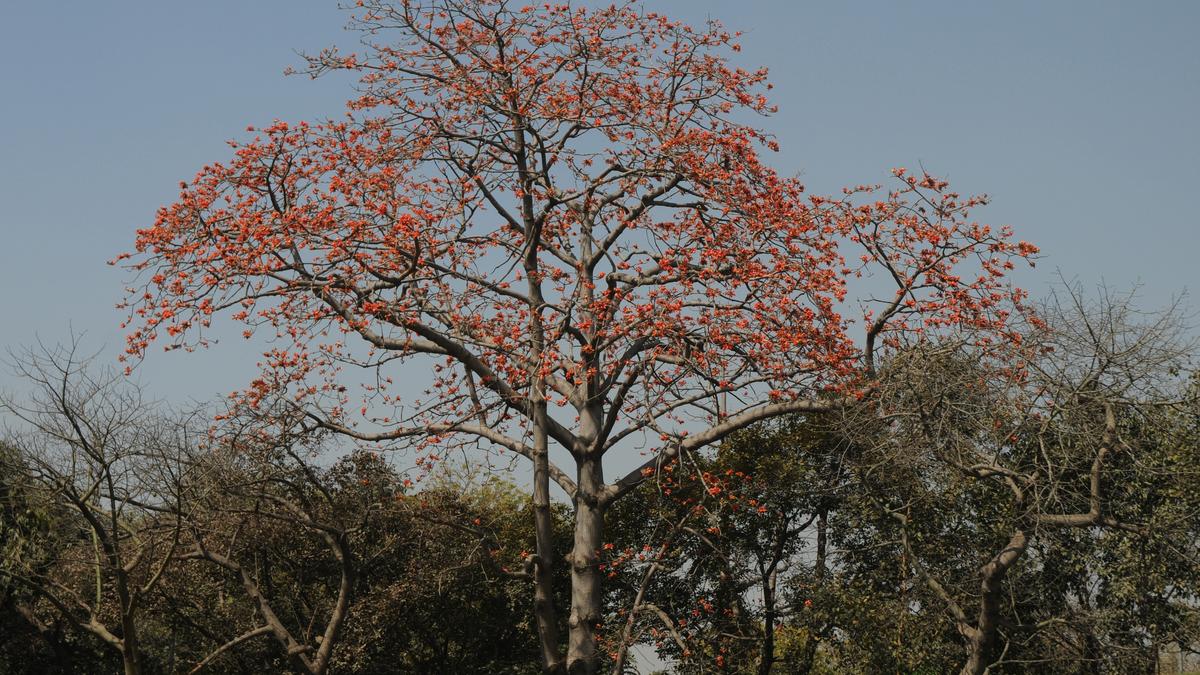
For Udaipur’s Holi, Rajasthan’s semal trees are going up in flames Premium
The Hindu
Udaipur's Holika Dahan celebration attracts locals and tourists, but the burning of semal trees raises ecological concerns.
On the eve of Holi in Udaipur, Subash Chowk, a prominent intersection surrounded by luxury hotels, is transformed. Bhajans and Bollywood songs blare from speakers and firecrackers fly into the sky. In the centre stands tall the Holika Dahan, a 50-foot-high tree sheathed in hay and set ablaze, sending tongues of flame leaping over a two-storey building. Locals and tourists alike throng the chowk to catch a glimpse. They circle the bonfire and celebrate a mythological victory of good over evil. This is one of Udaipur’s main attractions for Holi.
Central to the Holika Dahan festivities is the silk cotton tree (Bombax ceiba L.), known locally as semal. Traditionally, the debarked stem or branch of a semal tree is used as the bonfire’s main pillar. “It is astonishing to see the ecologically important semal tree sobbing in Udaipur’s tallest Holika Dahan. Its roots, fruits, seeds, stem, stem bark, and gum are all medicinally valuable,” Vartika Jain, an assistant professor at the Government Meera Girls’ College, Udaipur, wrote recently on the ‘Semal Conservation Mission’ Facebook group.
In 2009, Dr. Jain co-authored a paper reporting that around 1,500-2,000 trees or branches of semal were cut, debarked, and ignited during Holi in the Udaipur district in that year. Dr. Jain’s work suggests the situation is no better in 2024. Large quantities of semal are cut in southern Rajasthan, in places like Bhil and Garasia, and sold in Udaipur. The cutting violates a panoply of laws, from the Rajasthan Forest Act 1953 to the Forest (Conservation) Act 1980. The price varies from Rs 500 to Rs 1500 per tree, depending on its size. Once ubiquitous in the region, the crimson semal flower is now a rare sight.
Apart from the flowers, the silk cotton tree is characterised by its spiked trunk and fluffy seed pods, and is native to India. “It has multiple purposes and is useful to wild animals, insects, and even to tribal communities,” Satish Sharma, the ex-assistant conservator of forests, Udaipur, and an expert on Rajasthan’s biodiversity, said over phone.
According to Dr. Jain, semal is an integral species that holds the forest ecosystem together. The rock bees nestle on its branches because the tree’s spikes keep its predator, the sloth bears, away. Members of tribal communities consume the tree’s reddish root for food during the monsoons. Larvae of the moth Bucculatrix crateracma feed on its leaves. The golden-crowned sparrow weaves the lining of its nests with white cotton from its seeds. The Dysdercus bugs, the Indian crested porcupine, Hanuman langurs, and some other species feast on the nectar in its flowers. It is, as Dr. Jain put it, a “one-tree wildlife sanctuary”.
Members of the Garasia tribe in the area also believe they are descended from semal trees. To them and others, it provides opportunities for agroforestry and resources like food, fodder, and fuel wood. Members of the Kathodi tribe use its wood to craft musical instruments while those of the Bhil use it to make utensils.
The communities’ relationship with the semal is more strained today, however. Many members of these communities ‘prepare’ these trees for Holi in Udaipur and other parts of the state. “They don’t make much money from selling semal, but because they don’t have to grow, water, or protect it, the costs and effort are minimal, making semal sales beneficial for them,” according to Mr. Sharma. After 37 years with the forest department, he said he’s seen both the “conservation and the destruction of semal”.











